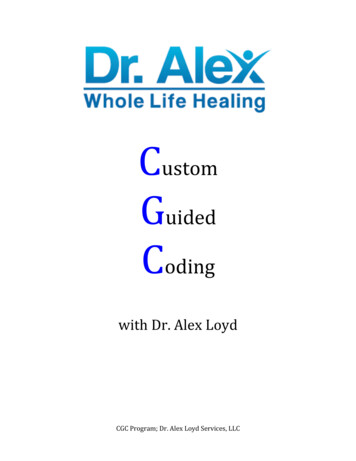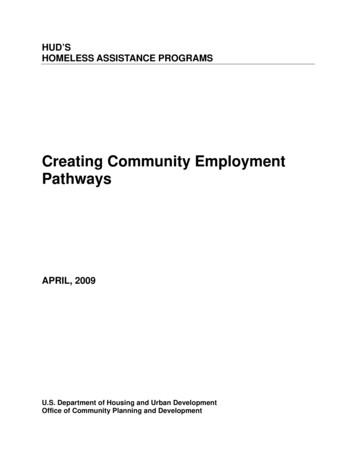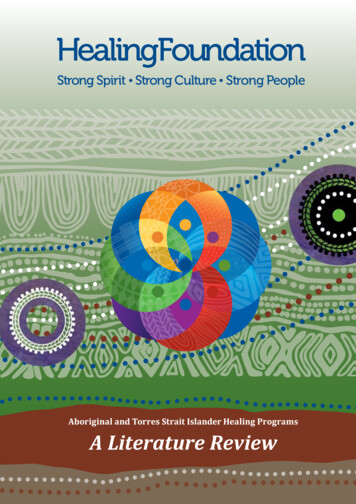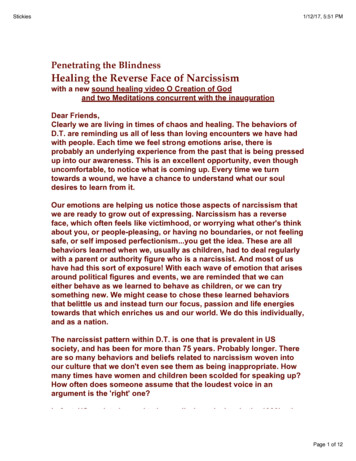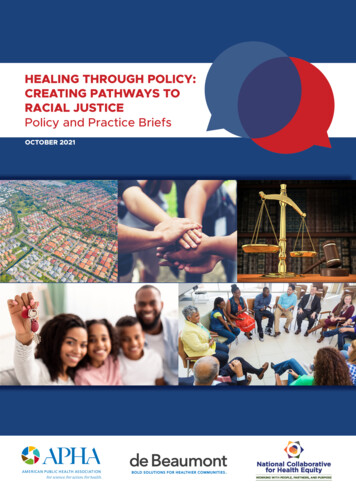
Transcription
HEALING THROUGH POLICY:CREATING PATHWAYS TORACIAL JUSTICEPolicy and Practice BriefsOCTOBER 2021
TABLE OF CONTENTSPAGE 1INTRODUCTIONPAGE 10NARRATIVE CHANGEPAGE 25RACIAL HEALING AND RELATIONSHIP BUILDINGPAGE 35SEPARATIONPAGE 55LAWPAGE 83ECONOMY
HEALING THROUGH POLICY:CREATING PATHWAYS TO RACIAL JUSTICEPOLICY AND PRACTICE BRIEFSIntroductionHealing Through Policy: Creating Pathwaysto Racial Justice is an initiative of the deBeaumont Foundation, the AmericanPublic Health Association, and theNational Collaborative for Health Equity.The goal of the first stage of the project isto curate a suite of policies and practicesthat can be implemented at the locallevel to promote racial healing andadvance racial equity.adopt Tobacco 21, the state legislatureadopted it in 2019, and later that yearin December, the policy was passed bythe federal government. This is a shiningexample of the power of local action tospur widespread change.As the COVID-19 pandemic revealed, apublic health crisis requires a responseequal to the scale and scope of thechallenge. This project aims to acceleratethe nation’s response to the healthcrisis created by racism and its myriadconsequences. Counties and cities canbe incubators for creative and innovativesolutions for addressing the most urgentneeds and priorities of communities.However, it must be acknowledged thatstate legislative decisions can shape thelandscape and options for local publichealth policies and practices.2 Manydecisions about funding and resourceallocations, particularly for large publicand private development projects,are driven by state politics. States’governments can also preempt localpolicy decisions. This intergovernmentalperspective is also required whenconsidering local strategies for addressingentrenched patterns of structural andsystemic racism.This project builds on the rapidlyexpanding consensus within publichealth that racism is a public healthcrisis.1 Decades of research andscholarship about the role of the socialdeterminants of health have increasedawareness about how racism driveshealth and subsequently influencesopportunities for health equity. Localjurisdictions can and do enact policiesand practices that can dramaticallyinfluence the conditions in which peoplelive, grow, work, and play.Tobacco 21 is a clear example. Thepolicy increases the age of purchase fortobacco products from 18 to 21, whichis critical for reducing smoking initiationin communities of color, especiallyamong children and youth, who areaggressively targeted by the tobaccoindustry’s marketing and advertising.As observed by CityHealth, an initiativeof the de Beaumont Foundation andKaiser Permanente, as more cities beganto adopt Tobacco 21, that momentumcatalyzed change at the state andnational levels. For example, in 2018, SanAntonio became the first Texas city toHealing Through Policy aims to providelocal leaders options for policies andpractices to move along the continuumfrom commitment to action for health,racial equity, and justice.1
Guiding PrinciplesThe founders of Healing Through Policydeveloped the following principles toground and guide the initiative:4. Our policy and practice options: 1. We recognize that the work ofeliminating racism and redressingcenturies of a culturally embeddedbelief in a false ideology ofhuman value hierarchy must becomprehensive in design andimplementation.Are guided by the Truth, RacialHealing & Transformation (THRTframework, which offers anoverarching comprehensivestrategy for adaptation by localcommunities and organizations tosupport progress toward neededsystemic transformation. 2. We aim to foster a cultural ethos andsustainable public policy and practiceagenda to help bridge divides andcreate health equity. The intentionis to transform not just policies andpractices, but also the beliefs andmotivation.Build upon the work of thepredecessors of social justice andthe existing work to advance racialequity, with room to promote andsupport innovation and creativityto address the unique challengesand priorities in each jurisdiction. Intend to serve as an approach,not a formula, to measurablechange. The suite of optionsaims to provide flexibility to meetthe needs of localities, given thevarying political and economicclimates and structures. Recognize that the long-termgoal of achieving racial equityis a process and not a one-timesolution.3. This work requires that we: Envision an equitable futurein which our nation hasacknowledged the harms fromcenturies of racial hierarchy andis committed to a path towardhealing to achieve the country’sespoused aspirational doctrinethat all are created equal. Develop and strengthen the skillsand capacity to reflect on our ownand others’ lived experiences,with empathy and compassion. Meaningfully incorporateracial solidarity by buildingand strengthening cross-racialrelationships and networks.2
FrameworkHealing Through Policy uses the TRHTframework, a comprehensive, national,and community-based process launchedby the W.K. Kellogg Foundationin partnership with several localfoundations across the country to planfor and bring about transformationaland sustainable change, and to addressthe historic and contemporary effects ofracism. TRHT recognizes that advancingracial equity and justice requiresrepairing past harms, addressing theunderlying beliefs that fuel racism, andfacilitating healing within and acrosscommunities.humanity, and to build trustingintergenerational and diversecommunity relationships that betterreflect our common humanity. Separation: The division of groupsbased on a particular characteristic,including race and/or socioeconomicstatus. It is fostered by historic andpresent-day land use and developmentdecisions that perpetuate racialinequities, such as segregation,colonization, and isolation, which leadto concentrated poverty and limitaccess to opportunity. Law: The laws, legal systems, publicpolicies, and accompanying practicesand norms through which systemicracism has been and continuesto be enforced at local, state, andnational levels. A transformed legaland public policy system honors thedignity of all people, upholds thecivil and human rights of all, andencourages full civic participationfrom all communities. Economy: Inequity is baked intoeconomic practices and policiesto sustain the false belief inhierarchy, thus shaping access andopportunity. Equitable policies aimto create an “economic democracy,where every person, family, andcommunity of all racial, ethnic, andcultural backgrounds can individuallyand collectively participate andthrive in the U.S. economy.”The TRHT framework offers anoverarching and comprehensive strategyfor adaptation by local communitiesand organizations to support progresstoward needed societal transformationthrough five pillars: Narrative Change: Transforming howwe communicate about our past,present, and future. It’s the “processof disrupting dominant narrativesthat normalize inequity and upholdoppression and advancing newnarratives from our communitiesand individuals in historicallymarginalized groups [to] imagine adifferent future.”3Racial Healing and RelationshipBuilding: Healing a societal racialdivide requires recognition of theneed to acknowledge the wrongsof the past, while addressing theconsequences of those wrongs.Racial healing involves focusingon ways for all of us to heal fromthe wounds of the past, to buildmutually respectful relationshipsacross racial and ethnic lines thathonor and value each person’sWhile the policies and practice categoriesare organized according to the TRHTpillars, we recognize the intersectionalityacross the components and assert thatthey all must be addressed to makemeaningful progress toward eliminatingracism and its deleterious effects onhealth and well-being.3
Summary of Proposed Policies and PracticesHealing Through Policy aims to providelocal leaders with a pragmatic andachievable, yet aspirational andinnovative set of policies and practicesthat can align with local priorities andneeds and meet the following criteria:1. Significant impact on healthand racial equity, supported byindependent evidence or expertopinion. Redesigning public spaces toequitably honor our shared history. Creating curricula that are respectful,inclusive, and honor the diversecommunities in which children attendschool.Racial Healing and RelationshipBuilding Resolutions, dialogue models, racialhealing circles, and restorative justicepractices aimed at understandinghistorical harms and repairingrelationships. 4. Successful implementation andsupport in at least one U.S. city orcounty.Training and capacity-building forpractitioners, educators, and serviceproviders around overcoming biasand healing. Local truth commissions thatpromote racial healing.5. Recommendation and approval by apanel of advisors.* Acknowledgement, public apologies,and commitments to redress bylocalities for their role in slavery and/or advancing systemic racism.2. Acknowledgement and addressinghistoric racial injustices anddemonstrates meaningfulengagement of impactedcommunities.3. Feasibility under local jurisdiction.Using these criteria as a guide, weanalyzed peer-reviewed and greyliterature and identified the followingcategories of policies and practices underthe five pillars of the TRHT framework.This suite of options provides examplesthat can guide localities in their workwhile providing the space for innovationand new practice generation.SeparationNarrative Change Executive orders, resolutions,ordinances, and declarations thatadvance equity. Mapping, data collection, and analysisefforts to understand and addressinequities. Racial impact assessments,frameworks, and other systems toachieve accountability.4 Zoning innovation for health andequity. Displacement and evictionprotections to preserve the right tohousing. Equitable transportation andplanning to improve access toopportunity. School integration to promote socialjustice and social mobility.
Law Endorsement and implementationof 21st Century Policingrecommendations and othercomprehensive police reforms.Voting rights protection andexpansion.EconomyDiversion of police funding tosupport alternatives to policing andprevention programs.Reclassification of violations,decriminalization, and bail,probation, and fees reform toaddress racial and socioeconomicbiases. Income and asset strategies topromote economic mobility ofindividuals and families. Equitable investment anddevelopment that builds oncommunity assets. Compensatory redress to rectifyhistorical policies that economicallydisadvantage communities of color.Immigrant-friendly policies andpractices to promote equitableopportunity.The table below summarizes the proposed policy and practices, and offers a fewexamples. Expanded descriptions and implementation examples are found in the policyand practice briefs.Policy and Practice CategoryExamplesNarrative ChangeExecutive orders, resolutions,ordinances, and declarations thatadvance equityMore than 200 states and cities have declared racism apublic health crisis.Mapping, data collection, andanalysis efforts to understandand address inequitiesThe HOPE Initiative provides state and national data tospur action toward health equity and an opportunityframework to set aspirational but achievable goals toimprove life outcomes, especially for populations of colormost affected by systemic racism and conscious andunconscious bias.Racial impact assessments,frameworks, and other systemsto achieve accountabilityThe Metropolitan Washington Council of Governmentsconvenes a Chief Equity Officers Committee that servesas the hub for regional collaboration and coordination onadvancing racial equity initiatives throughout the region.Redesigning public spaces toequitably honor our sharedhistoryVirginia’s Loudoun County Public Schools established aninterpretive display honoring Black individuals who madesignificant contributions related to education duringsegregation.Creating curricula that arerespectful, inclusive, and honorthe diverse communities inwhich children attend schoolColorado passed the “Know Justice Know Peace”resolution requiring the inclusion of Black, Indigenous,and Latino studies in the curriculum by 2022, providingprofessional development to teachers and administratorsaround discussing racially traumatic situations, andensuring that feedback loops are in place to ensurestudent competency and cultural responsiveness.5
Racial Healing and Relationship BuildingResolutions, dialogue models,Charleston, South Carolina passed a resolutionracial healing circles, andacknowledging and apologizing for their role in slaveryrestorative justice practicesand creating an Office of Racial Reconciliation.aimed at understanding historicalharms and repairing relationshipsTraining and capacity-buildingfor leaders, practitioners,educators, and service providersaround overcoming bias andhealingJefferson County Public Schools in Kentucky and NewYork City Public Schools are supporting implicit-biastraining in schools and robust training of educators inculturally competent classroom management. The goalis to improve disparities in academic outcomes anddisproportionate rates of suspension and expulsionamong students of color, which reflects a systemic bias inthe educational system.Local truth commissions thatpromote racial healingThe Greensboro Truth and Reconciliation Commission wasthe first local truth commission in the United States. Itwas followed by the Oklahoma Commission to Studythe Tulsa Race Riot of 1921 and the Byrd Foundation forRacial Healing, which aims to promote racial healing, fighthate crimes of any kind, and facilitate widespread publicdialogue on racial healing through educational programs.Acknowledgement, publicapologies, and commitmentsto redress by localities for theirrole in slavery and/or advancingsystemic racismPublic apologies for wrongdoing have occurred inplaces as diverse as Virginia’s Loudoun County PublicSchools and the city councils in Charleston, SouthCarolina; Asheville, North Carolina; and Tampa, Florida.SeparationZoning innovation for healthand equity Up-zoning, such as removing restrictions on singlefamily zoning, minimum lot sizes, and parkingrestrictions Inclusionary zoning Accessory dwelling units Zoning for food justiceDisplacement and eviction protections to preserve the right to housing Right to return or preference policyEquitable transportation andplanning to improve access toopportunity Incorporation of equity goals and equity-drivenprocesses into the fabric of agency planning andpolicy decisions Transit-oriented development that prioritizesaffordability and equity Income-based fares for public transit Controlled choice enrollment and transfer processesprioritizing socioeconomic integration Attendance zones and feeder patterns constructed toensure racial and economic diversity Expanded public school choice for familiesthrough interdistrict, magnet, and charter offeringsSchool integration to promotesocial justice and social mobilityRight to counselJust cause eviction6
LawEndorsement andimplementation of 21st CenturyPolicing recommendations andother comprehensive policereformsThe more recent editions of the President’s Task Forceon 21st Century Policing report focus on six pillars ofpolice reform: Pillar 1: Building Trust and Legitimacy Pillar 2: Policy and Oversight Pillar 3: Technology and Social Media Pillar 4: Community Policing and Crime Reduction Pillar 5: Training and Education Pillar 6: Officer Wellness and SafetyDiversion of police funding tosupport alternatives to policingand prevention programsIn 2020 budget votes, campaigns to reallocate funds tomeet community needs resulted in over 840 millionin direct cuts from local U.S. police departments, atleast 160 million investments in communities, and theremoval of law enforcement from schools in 25 cities.Reclassification of violations,decriminalization, andbail, probation, and feesreform to address racial andsocioeconomic biases Alternatives to arrest, incarceration, and supervision Individualized conditions for managing financialobligations Reduce pathways to incarcerationImmigrant-friendly policies andpractices to promote equitableopportunity Sanctuary policies Welcoming City plansVoting rights protection andexpansion Extending the right to vote in local elections to noncitizens Youth voting Amendments to timing of local elections toencourage greater civic participation Restoring voting rights to ex-offenders Raising the minimum wage and/or requiring a livingwage Universal basic income or guaranteed income Down payment and mortgage assistance to supporthomeownership as a path to building wealthEquitable investment anddevelopment that builds oncommunity assets Housing trusts Participatory budgeting Offices or task forces devoted to community wealthbuilding and comprehensive equity packages/fundsCompensatory redress torectify historical policies thateconomically disadvantagedcommunities of color Compensatory redress to individuals for past harms “Super fund” for community developmentand investment in Black American communities Tribal sovereignty acknowledgements and land returnEconomyIncome and asset strategies topromote economic mobility ofindividuals and families7
HEALING THROUGH POLICY ADVISORY COMMITTEE Donyel Barber, City of Gastonia (NC) City Council Debbie Chang, BlueShield Foundation of California Daniel Dawes, Satcher Health Leadership Institute, Morehouse School of Medicine Senator Bill Frist, M.D., Bipartisan Policy Center Fellow Angela Glover Blackwell, PolicyLink Grace Hou, Illinois Department of Human Services Dr. Anthony Iton, The California Endowment Dr. Clarion E. Johnson, de Beaumont Foundation Board of Directors Dr. Jeanette Kowalik, Trust for America’s Health Mitch Landrieu, former Mayor of New Orleans La Quen náay Liz Medicine Crow, First Alaskans Institute Dr. Jamila Porter, de Beaumont Foundation Eduardo Sanchez, American Heart Association Dr. Karen Smith, Consultant Dr. Steven Woolf, Department of Family Medicine and Population Health, VirginiaCommonwealth UniversityABOUT THE AMERICAN PUBLIC HEALTH ASSOCIATIONThe American Public Health Association champions the health of all people and allcommunities. We are the only organization that combines a nearly 150-year perspective,a broad-based member community and the ability to influence federal policy to improvethe public’s health. Learn more at www.apha.org.ABOUT THE DE BEAUMONT FOUNDATIONThe de Beaumont Foundation creates and invests in bold solutions that improvethe health of communities across the country. Its mission is to advance policy, buildpartnerships, and strengthen public health to create communities where everyone canachieve their best possible health. For more information, visit www.debeaumont.org.ABOUT THE NATIONAL COLLABORATIVE FOR HEALTH EQUITYThe mission of the National Collaborative for Health Equity is to promote health equityby harnessing data, developing leaders, and catalyzing partnerships across the manydifferent sectors that share responsibility for creating a more equitable and just society.Learn more at www.nationalcollaborative.org.8
ENDNOTES1American Public Health Association. Declarations of Racism as Public Health Crisis. https://apha.org/racism-declarations2Amsler, Lisa & Vieilledent, Thibault. (2021). Collaborative Governance in Local Government: How State Law ShapesCommunity Problem-Solving through Intrastate Preemption. Perspectives on Public Management and Governance.10.1093/ppmgov/gvab007.3Lynn, Jewlya & Kathlene, Lyn. (2020). Narrative Change for Health & Racial Equity: Exploring Capacity & Alignment. https://www.researchgate.net/publication/346811466 NARRATIVE CHANGE FOR HEALTH RACIAL EQUITY EXPLORINGCAPACITY ALIGNMENT9
NARRATIVE CHANGEAccording to the Truth, Racial Healing, & Transformation (TRHT)implementation guide, the concept of narrative change refers tothe fact that the human brain is hardwired to capture stories andassociated images to construct conscious and implicit meaning andbeliefs. Stories make up our individual and collective narrativesabout reality. Achieving racial equity and healing from the traumaof centuries of legal, institutional, and structured racial hierarchyrequires transforming our experiences, stories, and understandingsabout the equal and inherent value of all humanity.1At a practical level, narrative changerefers to transforming how wecommunicate about our past, present,and future. It’s the “process of disruptingdominant narratives that normalizeinequity and uphold oppressionand advancing new narratives fromour communities and individuals inhistorically marginalized groups [to] imagine a different future.”2 Thetask of creating new narratives abouthuman value means supporting effortsto create and distribute new, complex,and complete narratives in all the wayswe communicate, including throughentertainment, journalism, digital andsocial media, school curricula, museums,and monuments and parks.more effectively and productively towardcommunity-based change. The national— and international — change generatedby 2020’s racial justice movement vividlydemonstrates the enormous impact thatnarrative change can have.Narrative change also involves directconversations in multiracial, multiethnictables in communities. Doing socan influence people’s perspectives,perceptions, and behaviors about andtoward one another so that we can workNarrative change is a key part of buildinga shared reality of interconnectednessand equality. False beliefs in a hierarchyof human value are the bedrock onwhich this country was founded, asevidenced by the colonization of andStories or narratives are how we createmeaning. They shape what we perceiveto be true, possible, and good. Theyare central to the development of ourworldview and the values we holdsacred.3 These narratives create thescaffolding under which we co-createthe systems and structures that governour lives and influence our access toresources and our collective health andwell-being.10
continued theft from Indigenous peoples,the enslavement and institutionallysanctioned terrorizing of and systematictheft from African American communities,the internment of Japanese Americansand continued othering of AsianAmerican communities, and the historicand continued disenfranchisement andmarginalization of people of color. Thesenarratives are fundamentally aboutexcluding and dehumanizing certaingroups. As a result of these beliefs,individuals, organizations, and systemsoften unconsciously and unintentionallyreflect and perpetuate the structuraland institutional racism that is so deeplyembedded in our society.can create a downward spiral of hostilitythat fuels further toxic polarization.”4Disrupting polarization requires thatwe collectively overcome the enduringlegacies of racism, colonization,marginalization, and the false beliefin a racial hierarchy. Drawing fromLouison Lavoy, “to counter and inoculateagainst false messages, society mustfind a way to rebuild a shared realitythat will encourage positive forms ofcommunication.”5 Below is a suite ofpolicies and practices that localitiescan implement to build narratives ofinterconnectedness that are sustainableand grounded in data and equity.States and localities play an importantrole in changing the narrative related toshared values and interconnectedness.Entities at these levels can undertakeand implement a variety of policiesand practices, including executiveorders, resolutions, ordinances, anddeclarations to advance racial equity;mapping, data collection, and analysisto understand and address inequitiesand measure progress; racial impactassessments and other systems toachieve accountability; reimaginingpublic spaces to equitably honorour shared history; and advocacyfor and creation of curricula that arerespectful, inclusive, and honor thediverse communities in which childrenattend school. These are not the onlyplaces that narrative change plays animportant role in states and localities.We recognize the interconnectednessof narrative change and other areasof the TRHT framework. These issuesare intersectional and oftentimes nonlinear. There are critical areas suchas democracy and voter suppressionas well as exclusionary immigrationpolicies that are supported by harmfuland exclusionary narratives. TheseWe live in an increasingly polarizedenvironment that drives false andexaggerated beliefs about ourdifferences and contributes to thedehumanization of people who live,look, speak, and act differently than wedo. Research from Beyond Conflict’sPolarization Index Project asserts that“when polarization in the United Statesbecomes more about identity thandisagreement on issues, it becomestoxic. Increasingly, Americans whoidentify themselves as either Democratsor Republicans view one another lessas fellow citizens and more as enemieswho represent a profound threat to theiridentities, creating a form of Americansectarianism. .Once we adopt the lensof ‘us vs. them,’ a range of unconsciouspsychological processes take root thataccelerate toxic polarization and distortthe ways we see one another andunderstand the world around us. Themore we feel disliked and dehumanizedby members of the other party, the morelikely we are to express greater dislikeand dehumanization toward them. Inthis way, the divide between actual andperceived dislike and dehumanization11
areas of policy have been reflected inthe Separation and Law briefs.We’ve chosen these policy and practicecategories because they: Recognize the emergent and evolvingnature of efforts to dismantle racismand its foundational false belief in ahierarchy of human value. Promote and support innovationand creativity to address the uniquechallenges and priorities in a givenjurisdiction. Stimulate and accelerate the paceof innovation to address systemicracism and other structures ofinequity.KEY POLICY AND PRACTICE EXAMPLESExecutive orders, resolutions, ordinances, and declarations toadvance racial equityIncreasingly publicized instances ofpolice brutality, along with the starkinequalities exacerbated by the COVID-19pandemic, have spurred action in statesand localities across the country. Severalstates, cities, and localities have turnedto executive ordinances, resolutions, anddeclarations as tools to advance racialand health equity. More than 200 states,cities, and localities have declared racisma public health crisis. These statementsare a first and important step to narrativechange in that they illuminate thestructural nature of inequality, creatingspace for dialogue and collaboration, andspurring changes across all sectors ofgovernment to shrink racial health gaps.There is evidence that these ordinanceslead to further action. In 2017, afterWisconsin was the first state to proclaimracism a public health crisis, more than4,000 county employees, including judgesand police, received racial equity training,according to Nicole Brookshire, directorof the county’s Office on African AmericanAffairs.6county government to identify andaddress policies, practices, and powerstructures that, whether intentionallyor unintentionally, work in favor ofwhite people and create barriers forBlack, brown, and Indigenous people.The ordinance commits to building amore diverse and inclusive workforce;ensuring Milwaukee County employeesat all levels are involved in designingequitable programs and services thatmeet the needs of the community;creating opportunities for communitymembers to co-design services; trackingand analyzing data to better understandthe impact of county services;generating new sources of revenue;implementing additional efficienciesto address the structural deficit; andmaking needed investments to advanceracial equity. Similar ordinances andresolutions to address structuralracism and advance racial equity havebeen implemented across the countryin many places, including Carlisle,Pennsylvania; Dane County, Wisconsin;Minneapolis; Spokane, Washington;Southfield, Michigan; Wheat Ridge,Colorado; and the state of California.One year after declaring racism apublic health crisis, Milwaukee Countypassed an ordinance that commits the12
There are also regional efforts to dothis work. The Washington, D.C. area’sMetropolitan Washington Councilof Government (MWCOG) passed aresolution to embed anti-racism andequity into MWCOG’s operations anddecision-making. The National Associationof Attorneys General — a nonpartisanorganization of 56 state and territoryattorneys general — launched AttorneyGeneral Karl A. Racine’s presidentialinitiative, “The People v. Hate: Standing Upfor Humanity.” The initiative aims to workwith attorneys general to raise awarenessof hate and bias, prevent hate from takingroot in communities, support residentswho have experienced hate, and developand share best practices on improvinghate crime data. The National Civic Leaguehas created model orders and ordinancesfor states and localities to adapt, includingexecutive ordinances on diversity trainingfor board and commission members,police accountability, and racial justice.Mapping, data collection, and analysis efforts to understandand address inequities and measure progressData collection and analysis, particularlydisaggregated data collection and analysis,are crucial steps in mapping progresstoward equity. Creating timely systems fordata collection and analysis are importantsteps toward documenting progressand motivating action to achieve greaterequity. Mapping can be a powerful toolin changing the narrative of how raciallymarginalized and economically divestedcommunities came into existence and thepolicy choices and governmental decisionsthat have perpetuated disparities. Many ofthe localities that have declared racism apublic health crisis have used racial equityanalyses and other forms of data analysisto frame the disparate impact of publichealth problems and identify solutions.Researchers, universities, hospitals, healthsystems, and eve
HEALING THROUGH POLICY: CREATING PATHWAYS TO RACIAL JUSTICE Policy and Practice Briefs OCTOBER 2021. . is a process and not a one-time solution. 3 Framework Healing Through Policy uses the TRHT . Inequity is baked into economic practices and policies to sustain the false belief in hierarchy, thus shaping access and


